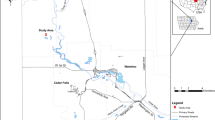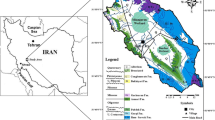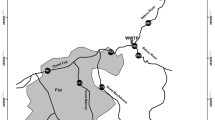Abstract
Wetlands are effective in the treatment of polluted surface water. A semi-natural wetland pilot plant was established to verify the pollutant abatement effectiveness of the Venice Lagoon inlet water. The unique conditions of this brackish environmental site are: (1) a high concentration of carbonate and low concentrations of sulphides, and (2) the abundance of organic matter in sediments. The goal of this study was to examine how these characteristics influence the metal mobility in the wetland and to compare our results to published literature. The data collected were limited with respect to statistical analysis because the metal concentrations were often below the detection limits. Therefore, we chose to perform non-parametric analyses. To analyse the relationships among heavy metal concentrations and the physical and chemical wetland variables, and to investigate the processes of metal removal, we performed a multivariate statistical analysis and a Spearman correlation analysis. The results indicated that the reduced and basic conditions of the sediments seen in the Venice Lagoon environment facilitated the removal of metals due to the formation of insoluble compounds with sulphides and carbonates.






Similar content being viewed by others
References
ARPAV, (2004). Carta dei suoli del bacino scolante in laguna di Venezia. Osservatorio Regionale Suolo, Castelfranco Veneto (TV). Italy
Bates, A. L., Orem, W. H., Harvey, J. W., & Spiker, E. C. (2002). Tracing sources of sulfur in the Florida Everglades. Journal of Environmental Quality, 31, 287–299.
Bertolin, A., Frizzo, P., & Ramazzo, G. (1995). Sulphide speciation in surface sediments of the Lagoon of Venice: A geochemical and mineralogical study. Marine Geology, 123, 73–86.
Buykx, S. E. J., van den Hoop, M. A. G. T., & Loch, J. P. G. (2002). Dissolution kinetics of heavy metals in Dutch carbonate- and sulfide-rich freshwater sediments. Journal of Environmental Quality, 31, 573–580.
DeVolder, P. S., Brown, S. L., Hesterberg, D., & Pandya, K. (2003). Metal bioavailability and speciation in a wetland tailings repository amended with biosolids compost, wood ash and sulfate. Journal of Environmental Quality, 32, 851–864.
Dixit, S., & Hering, J. G. (2003). Comparison of arsenic (V) and (III) sorption onto iron oxide minerals: Implications for arsenic mobility. Environmental Science & Technology, 37, 4182–4189.
Elder, J. F. (1988). Factors affecting wetland retention of nutrients, metals, and organics. In: J.A. Kusler and G. Brooks (eds.), Proceedings for the national wetland symposium: wetland hydrology (p. 178–184). 16–18 Sept. 1987. Chicago, IL.
Fendorf, S., La Force, M. J., & Li, G. (2004). Temporal changes in soil partitioning and bioaccessibility of arsenic, chromium, and lead. Journal of Environmental Quality, 33, 2049–2055.
Fox, P. M., & Doner, H. E. (2003). Accumulation, release and solubility of arsenic, molybdenum and vanadium in wetland sediments. Journal of Environmental Quality, 32, 2428–2435.
Green, C. H., Heil, D. M., Cardon, G. E., Butters, G. L., & Kelly, E. F. (2003). Solubilization of manganese and trace metals in soils affected by acid mine runoff. Journal of Environmental Quality, 32, 1323–1334.
Guo, T., Delaune, R. D., & Patrick, W. H. Jr. (1997). The effect of sediment redox chemistry on solubility/chemically active forms of selected metals in bottom sediment receiving produced water discharge. Spill Science and Technology Bulletin, 4, 165–175.
Howarth, R. W., Stewart J. W. B., & Ivanov, M. V. (1992). Sulphur cycling on the continents. Wetlands, terrestrial ecosystems and associated water bodies. Paris, France: Scientific Committee on Problems of Environment (SCOPE).
ITRC (Interstate Technology & Regulatory Council). (2003). Technical and Regulatory Guidance Document for Constructed Treatment Wetlands. WTLND-1. Washington, D.C.: Interstate Technology & Regulatory Council, Mitigation Wetlands Team. Retrieved from: http://www.itrcweb.org
Kadlec, R. H., & Knight, R. L. (1996). Treatment Wetlands. Boca Raton, FL, USA: Lewis.
Karpiscak, M. M., Whiteaker L. R., Artiola J.F., & Foster K. E. (2001). Nutrient and heavy metal uptake and storage in constructed wetland systems in Arizona. Water Science and Technology, 44, 455–462.
Knox, A. S., Gamerdinger, A. P., Adriano, D. C., Kolka, R. K., & Kaplan, D.I. (1999). Sources and practices contributing to soil contamination. American Society of Agronomy. Bioremediation of contaminated soils, Agronomy Monograph no. 37.
Lasat, M. M. (2002). Phytoextraction of toxic metals: A review of biological mechanisms. Journal of Environmental Quality, 31, 109–120.
Legendre, P., & Legendre, L. (1998). Numerical Ecology. Amsterdam, The Netherlands: Elsevier Scientific Publishing Company.
Linge, K. L., & Oldham, C. E. (2002). Arsenic remobilization in a shallow lake: The role of sediment resuspension. Journal of Environmental Quality, 31, 822–828.
Machate, T., Heuermann, E., Schramm, K., & Kettrup, A. (1999). Purification of fuel and nitrate contaminated ground water using a free water surface constructed wetland. Journal of Environmental Quality, 28, 1665–1673.
Masscheleyn, P. H., Delaune, R. D., & Patrick, W. H. (1991) Arsenic and selenium chemistry as affected by sediment redox potential and pH. Journal of Environmental Quality, 20, 522–527.
MIPAF (1999). Decreto Ministeriale 13 settembre 1999. Approvazione dei “Metodi ufficiali di analisi chimica del suolo.” Gazzetta Ufficiale n. 248 del 21–10–1999.
O’Day, P. A., Vlassopoulos, D., Root, R., & Rivera, N. (2004). The influence of sulfur and iron on dissolved arsenic concentrations in the shallow subsurface under changing redox conditions. PNAS, 101, 13703–13708.
Quian, J., Zayed, A., Zhu, Y., Yu, M., & Terry, N. (1999). Phytoaccumulation of trace elements by wetland plants: III. Uptake and accumulation of ten trace elements by twelve plant species. Journal of Environmental Quality, 28, 1448–1455.
Regione Veneto (2000). Piano per la prevenzione dell’inquinamento e il risanamento delle acque del bacino idrografico immediatamente sversante nella laguna di Venezia. Venice, Italy.
Ryu, H. W., Moon, H. S., Lee, E. Y., Cho, K. S., & Choi H. (2003). Leaching characteristics of heavy metals from sewage sludge by Acidithiobacillus thiooxidans MET. Journal of Environmental Quality, 32, 751–759.
Scholz, M. (2003). Performance predictions of mature experimental constructed wetlands which treat urban water receiving high loads of lead and copper. Water Research, 37, 1270–1277.
Shen, Z. G., Li, X. D., Wang, C. C., & Chen, H. M. (2002). Lead phytoextraction from contaminated soil with high-biomass plant species. Journal of Environmental Quality, 31, 1893–1900.
Sheoran, A. S., & Sheoran, V. (2006). Heavy metal removal mechanism of acid mine drainage in wetlands: A critical review. Minerals Engineering 19, 105–116.
Shutes, R. B. E., Revitt, D. M., Scholes, L. N. L., Forshaw, M., & Winter, B. (2001). An experimental constructed wetland system for the treatment of highway runoff in the UK. Water Science and Technology, 44, 571–578.
StatSoft, Inc. (2001). STATISTICA for Windows [Computer program manual]. Tulsa, OK.
Stewart, M. A., Jardine, P. M., Barnett, M. O., Mehlhorn, T. L., Hyder, L. K., & McKay, L. D. (2003). Influence of soil geochemical and physical properties on the sorption and bioaccessibility of chromium(III). Journal of Environmental Quality, 32, 129–137.
Sukreeyapongse, O., Holm, P. E., Strobel, B. W., Panichsakpatana, S., Magid, J., & Hansen, H. C. B. H. (2002). pH-dependent release of cadmium, copper and lead from natural and sludge-amended soils. Journal of Environmental Quality, 31, 1901–1909.
Van Den Berg, G. A., Loch, J. P. G., Van Der Heijdt, L. M., & Zwolsman, J. J. G. (1998). Vertical distribution of acid-volatile sulfide and simultaneously extracted metals in a recent sedimentation area of the river Meuse in The Netherlands. Environmental Science & Technology, 17, 758–763.
Voegelin, A., Barmettler, K., & Kretzschmar, R. (2003). Heavy metal release from contaminated soils: Comparison of column leaching and batch extraction results. Journal of Environmental Quality, 32, 865–875.
Wen, X., & Allen, H. E. (1999). Mobilization of heavy metals from Le An River sediment. The Science of the Total Environment, 227, 101–108.
Wijnja, H., & Schulthess, C. P. (2000). Interaction of carbonate and organic anions with sulfate and selenate adsorption on an aluminum oxide. Environmental Science & Technology, 64, 898–908.
Willow, M. A., & Cohen R. R. H. (2003). pH, dissolved oxygen and adsorption effects on metal removal in anaerobic bioreactors. Journal of Environmental Quality, 32, 1212–1221.
Wood, T. S., & Shelleym, M. L. (1999). A dynamic model of bioavailability of metals in constructed wetland sediments. Ecological Engineering, 12, 231–252.
Yang, J.-K., Barnett, M. O., Jardine, P. M., Basta, N. T., & Casteel, S. W. (2002). Adsorption, sequestration and bioaccessibility of As(V) in soils. Environmental Science & Technology, 36, 4562–4569.
Ye, Z. H., Whiting, S. N., Quian, J. H., Lytle, C. M., Lin, Z. Q., & Terry, N. (2001). Trace elements removal from coal ash leachate by a 10-year-old constructed wetland. Journal of Environmental Quality, 30, 1710–1719.
Zhang, M., He, Z., Calvert, D. V., Stoffella, P. J., & Jiang, X. (2003). Surface runoff losses of copper and zinc in sandy soils. Journal of Environmental Quality, 32, 909–915.
Acknowledgements
The project was funded by the Venice Water Authority (Ministero Infrastrutture e Trasporti) and coordinated by its concessionaire Consorzio Venezia Nuova (CVN). We gratefully acknowledge the assistance of Alberto Giulio Bernstein, Head of the Environmental Engineering Department of CVN. We also thank Protecno srl (Italy) for the provision of the hydraulic data and raw analysis, and Labcontrol snc (Italy) for assisting with the chemical analysis.
Author information
Authors and Affiliations
Corresponding author
Rights and permissions
About this article
Cite this article
Mattiuzzo, E., Favero, L., Zennaro, F. et al. Heavy Metal Behaviour in an Experimental Free Water Surface Wetland in the Venice Lagoon Watershed. Water Air Soil Pollut 183, 143–151 (2007). https://doi.org/10.1007/s11270-007-9363-7
Received:
Accepted:
Published:
Issue Date:
DOI: https://doi.org/10.1007/s11270-007-9363-7




